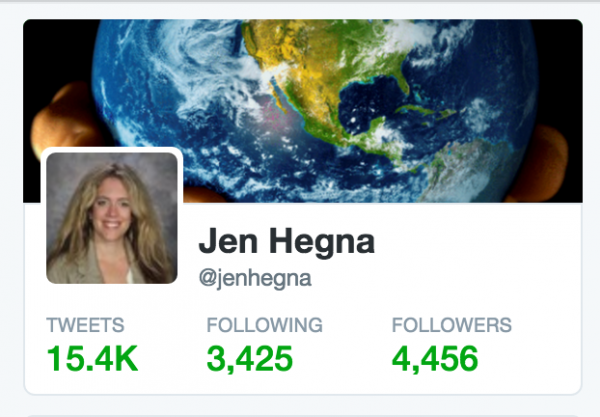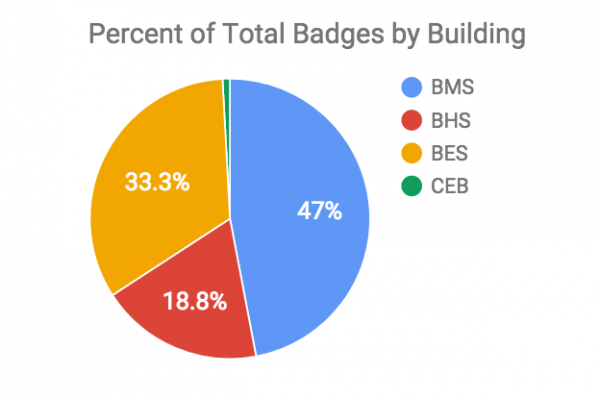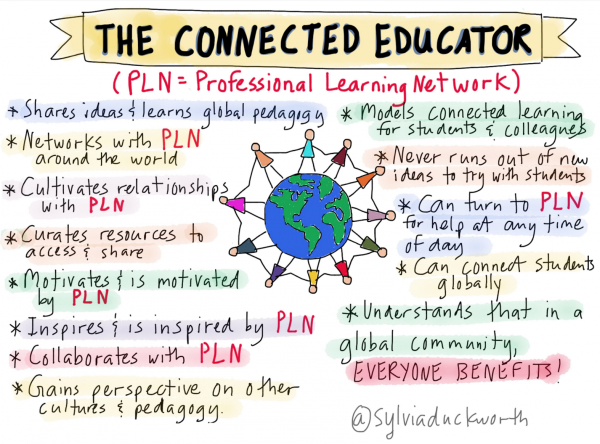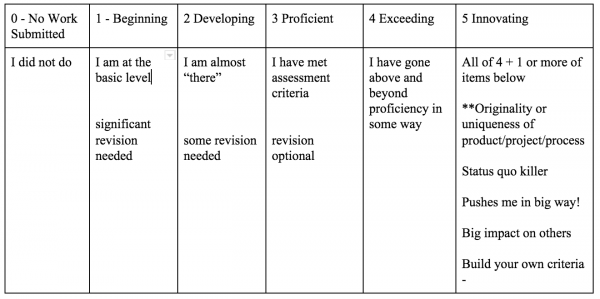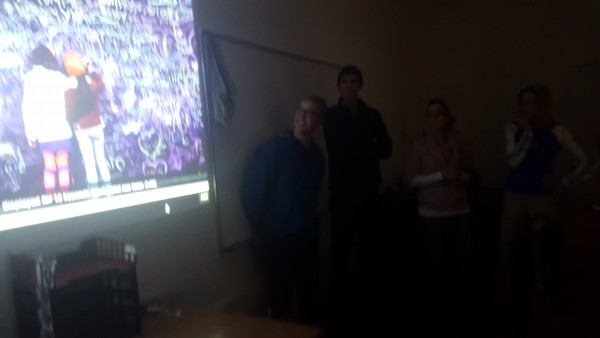This past week my grad students (in course Connected Educator, Connected Classroom) began blogging and self assessing their current connectedness. I decided it was a good time for me to do my own reflection and current practice with my personal learning network.
A brief PLN history. It’s ironic, I stumbled on an old blog post of mine called My Reflection on Blogs from 2009 that was an assignment during MY Grad program from the University of Wisconsin Stout – eLearning graduate certificate program. In the post, I talk about my thoughts of blogs – and how boring mine was, how I appreciated blogs with opinions and a strong author’s voice. Still true today. But what I absolutely loved – was a concept map I created of where my PLN was at that moment.
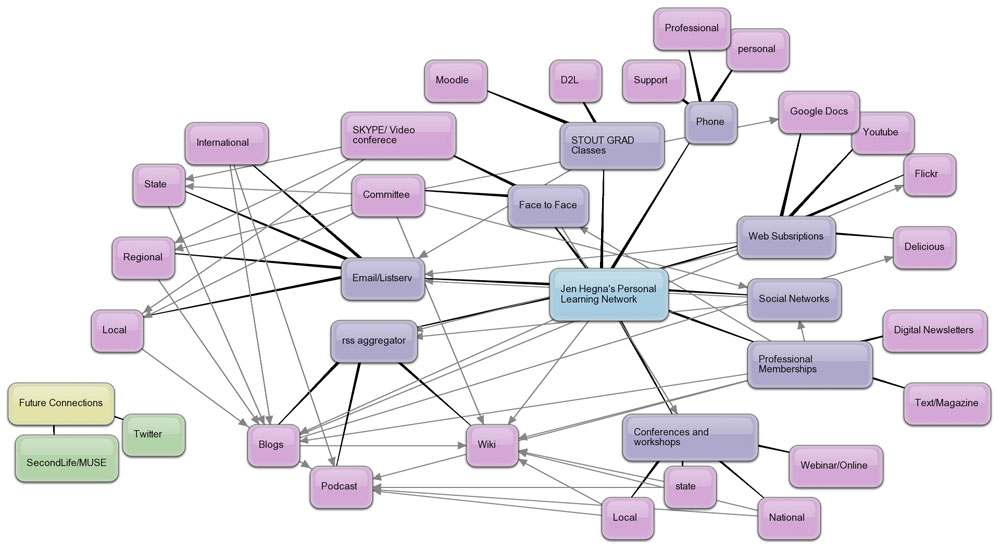 Jen Hegna – PLN – Jan. 2009
Jen Hegna – PLN – Jan. 2009
Social networks and wiki’s were a big deal for me back then. I was lurker, learner, contributor of these types of networks had created and facilitated these types of networks for my school and groups I was associated with. I also subscribed to discussion boards that would be delivered to my email. The H-NetEdtech board was my favorite and would have new content delivered nearly every day. I had a few blogs I subscribed to and learned from on a regular basis as well as podcasts. I had an iPod, but it was not wireless – to download new content the iPod needed to be tethered to a computer. I had a SMART phone – but I believe it was sort of Palm Pilot that was cool (at the time) because I could have my calendar on it (again, after a tethered sync) and email! Whoo HOO! While I felt I had an established PLN. My future desires was to work with Twitter and Second Life to support my learning.
Second Life never really panned out for me. It was something I was investigating during my masters degree. It was cool, you could meet and chat face to face with people and you could go visiting and building other destinations. (Reminds me a lot of minecraft today)
Twitter on the other would become a significant part of my learning. I decided to search for my very first tweet. Not the most clever tweet now was it? But that tweet would become the first of 15, 400 tweets (as of Jan 26 – around midnight!) Sometime late fall of 2009 or early 2010 – I received my first TRUE Smart phone. I believe it was a Motorola Droid (of some sort). This changed things and mobile learning became an essential part of my growth!
My PLN today.
Twitter. Twitter is my primary learning tool of choice. What was once a wish, is now my reality. I have gone through all the phases of twitter use and today, twitter is just what I do. Participating and moderating in Twitter chats has really created new learning connections for me. My top – most favorite chat is #mnlead on Sunday nights at 7pm CST. I also enjoy #plearnchat on Mondays and lurk and learn from a ton of other hashtags that fill my tweetdeck columns. Some of my favorites today – #makered, #pblchat, #sblchat, #leadwithgiants, #sunchat, #divergED, #tosachat, #satchat, #designthinking. (there are many more!) Frequency of use – I use twitter every day, multiple times a day but mostly at night and on weekends. I use it to learn and have conversations with other people on learning journeys. I use it to share ideas and share great things I see in my district. Its a regular part of my routine.
Social Networks. Nings and wiki’s have been replaced by Facebook and Google+ Communities. I do have a Facebook account BUT I use it primarily for personal use. Recently, I have been joining groups on FB. Some of my favorites – TTOG (teachers throw out grades) Hack Learning, and my newest group BreakoutEdu. I also “LIKE” pages like Edutopia, Teachthought, and Mindshift because I enjoy a little “sprinkling” of PD on my personal wall about educational innovations. Google+ communities is used less frequently but there is great potential in connecting. I also like how it integrates with Google Apps and Gmail. I have created a few Google communities but haven’t been the best facilitator. It really shouldn’t be about me – it should be about the group – but sometimes we need people to keep the convo going. I probably should try to bring some life back to them. Frequency of use – I use Facebook every day – usually early morning and at night because of the personal connections to family/friends. Google communities are used sporadically several times per week.
Video Conferencing. I don’t remember the last time I used Skype (literally – I think it has been at least 2 years). My new video platforms of choice – Google Hangouts (GHO) and Periscope. I also love Google Hangouts on Air as a way to stream video live and it records to Youtube. Here is a recent hangout I did with Kim Hurd (@khurdhorst) in taking a tour of her classroom! We had approximately 9 people watching it live and asking questions. I think the best part of this tool is that it archives to YouTube so I can share it out, review it later. Something I wish Periscope would do as the streams only last for 24 hours. So- you have to remember to save your videos to your camera after recording – and then upload them to YouTube later. I was playing around with my phone – there may be a setting within my Google Backup that will allow me to save periscope videos to my Google Account. Fingers crossed. Frequency of use – I use both google hangouts and periscope on a weekly basis. I have weekly team meetings using GHO. I do watch several periscopes a week (just because I am notified via my phone). But actually facilitating a GHO or publishing a periscope – is probably a couple times per month.
Blogs. Reading and subscribing to Blogs that make me think are daily routine for me. I use Feedly to track all of my content. The majority of my content consists of educational leadership and edtech with a sprinkling of entrepreneurs and business blogs. For the blogs I REALLY like – I will subscribe via email just because I am in my email – much more frequently than feedly. Blogs that I read that spark my interest will usually get tweeted out to my pln. Frequency of use – Nightly/Weekends. As for writing blogs – this is sporadic and is a big area in which I want to improve.
Voxer. One of my newest PLN favorites is Voxer. I will admit – I didn’t like it at first and took some time for me to get use to. Twitter is transparent and open. You can jump in and out of conversations with other folks and its totally OK. Voxer – is a little less open but allows people to get deeper with conversations. I believe this can improve the relationships of the participants. My first voxer group was MN Educators on Voxer and it took me some time to figure out the communication norms. From what I understand – in my short 7 mos of true PLN voxer experiences – conversations may change from time to time – but everyone tends to discuss and contribute to the same topic. Its very awkward when people randomly come into the conversation with topics outside of the scope of the convo. I have been that random person – and its helpful to listen/read the past posts to know the topic at hand. Check out these other Voxer Norms via Tammy Neil (@TG_Neil) Frequency of use – Daily, multiple times a day. Mostly before and after work on my 25 minute commute.
I still am connected to a couple of email groups, I subscribe to Youtube content, have a LinkedIn account, and do follow great people and pin great things on Pinterest. From time to time – I will even pick up the old telephone or meet my PLN at a f2f conference or edcamp! If I had to guess – all in all I spend an average of 7-12 hours each week on my professional growth. Some weeks less – some weeks more. Sometimes its a couple of minutes – other times it hours (like writing this blog post over the course of 3 days). I am not saying that this is a good amount of time and effort spent on learning – but some time towards my growth is going to be better than no time towards my growth.
While this is where I am today – I certainly have hopeful goals of where I want to be. But that – is for a future post!

